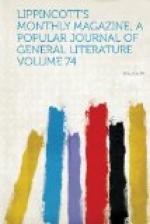The men row vigorously, and the frail skiff skims along the water at a rate of speed equal to an express-train. But the rushing of the rippling waters past the boat is the chief indication of the rapidity of our progress, so smoothly do we glide along. One peculiarity of the caique is that there are no rowlocks for the oars, which are held by a loop of leather fastened on the boat.
All the senses are soothed and steeped in Elysium during this rapid transit. The eye lazily runs over the squat-looking red houses with flat roofs which line the shore, to rest on the dark cypress trees which fill the intervening spaces, with the gilded balconies of some pleasure-palace of sultan or high Turk catching the sight occasionally. Caiques similar to your own are darting about in all directions, following, passing or meeting you, until at length you reach your destination, indicated by the crowd of caiques tied up there, like cabs on a grand-opera night waiting for their customers. Those of high Turkish functionaries or foreign ambassadors are very different from yours—as different as a coach-and-four from a common cab. Many of these have twelve rowers, all in fancy uniforms—red fezzes and jackets embroidered with gold—while the larger caiques are profusely and expensively ornamented.
Stepping ashore, you see a long line of carriages drawn up in several rows, and of every conceivable variety—from the Turkish araba to the most coquettish-looking Parisian coupe—gilded and adorned in a style to make a French lorette stare with amazement at a lavishness of expenditure exceeding her own.
The fair ones to whom these carriages belong may be seen in the distance squatting down on rugs spread out beneath the trees, and sipping coffee or sherbert while listening to musicians or story-tellers. You stroll toward them as near as their attendant guardians—grim-looking black eunuchs armed to the teeth, and quite ready to use those arms with very little provocation on the persons of any “dogs of infidels” who may interfere or seem to interfere with their fair charges—will permit.




